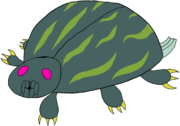Gourdboring Pulpibeetle
| Gourdboring Pulpibeetle | |
|---|---|
| Enemy | |
| Family | Coleopest |
The Gourdboring Pulpibeetle is a species of larger coleopest that leeches off of gourds.
In fanon games
Below this point is where users place their version of the Gourdboring Pulpibeetle.
In Pikmin: Interstellar Cryptid
|
This article or section presents information pertaining to Pikmin: Interstellar Cryptid, a fanon game created by CarrotStilts1. |
| |||
|---|---|---|---|

| |||
| Scientific name | Hortanguisous cucurpallium major | ||
| Family | Coleopest | ||
| Caves | Squash Stronghold | ||
| Carry weight | 20 | ||
| Max. carriers | 30 | ||
| Seed worth | 35 | ||
| Attacks | Eats, crushes, and scares Pikmin, spits adhesive | ||
The Gourdboring Pulpibeetle is a boss in Pikmin: Interstellar Cryptid. It is the larger counterpart to the Charteuse Pulpibeetle. Compared to its smaller counterpart's weevil-like complexion, the Gourdboring Pulpibeetle is more standard and similar to the Armored Cannon Beetle. It has a green carapace with lighter streaks, bulbous feet with yellow claws, and a growth on its abdomen resembling the cut stem of a gourd. It has pink eyes, and an unnerving crab-like mouth. It appears on the final sublevel of the first cave, Squash Stronghold, alongside Pumpkin Pikmin. However, due to the electric gate blocking the hole to this sublevel, it can only be explored after Yellow Pikmin are found in Artisan Aqueduct.
It is initially found buried in the pulpy floor of the pumpkin the cave is located within. Its shell is the only part sticking out of the ground. When approached, it will emerge from the ground and let out a roar that panics most Pikmin, bar Pumpkin Pikmin. It will then pursue the squad, leaping into the air and attempting to flop onto them. When it lands, it will be partially stuck in the floor and its carapace will open, revealing its milky white abdomen that can be attacked until it gets itself unstuck. If it approaches Pumpkin Pikmin, it will eat them, but it doesn't do the same with other species of Pikmin due to its specific diet on gourds. It can also take flight, exposing its abdomen in the process, and spit strands of weak adhesive at Pikmin. While no story mode Pikmin are resistant to adhesive, it's weak enough for them to quickly escape it. While flying, the Gourdboring Pulpibeetle will occasionally screech to panic Pikmin some more, and they'll often run into the strands of adhesive in the process. While the Pikmin are stuck, the beetle will cut its flight short to deliberately fall onto them.
As a final tactic of defense, the insect will bore back into the ground, looking as it did before the fight started. It will then begin spinning intensely, throwing chunks of pumpkin pulp everywhere that scatter Pikmin they hit and obscure the vision of any leaders hit by them as well.
Notes
Olimar's notes
- “A mighty insect that bores into certain cultivars of squash to feed off of their internal pulp. The creature is normally passive but becomes aggressive when under stress. Notably, it often secretes a viscous, sugary fluid comparable to honeydew from its abdomen when under the right stimuli and perfectly healthy. Because of this, creatures such as scarpanids and shearants will often treat the gourdboring pulpibeetle like cattle, as the liquid is essentially candy to them.”
Louie's notes
- “Like a jackfruit, this creature's flesh absorbs the juices of whatever it is cooked with and becomes nearly identical in flavor, but with an addictive, chewy texture. The honeydew can be used as a glaze for sweet pastries as well!”
Bentley's notes
- “The cave we found this creature in was actually the entrails of a massive vegetable. The way it bored into the plant's flesh to bunker down, and then spun to kick up harmful debris like some sort of alien robot in a sci-fi horror was truly a sight to behold... until I got pumpkin guts all over my helmet and couldn't see.”
Eloise's notes
- “I'd imagine this creature would be of agricultural significance if this planet ever gets colonized. But whether or not it'd be due to what it produces or its nature as a pest... I have no idea.”
